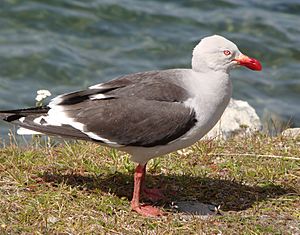Dolphin gull facts for kids
Quick facts for kids Dolphin gull |
|
|---|---|
 |
|
| In Beagle Channel, Argentina | |
| Conservation status | |
| Scientific classification | |
| Genus: |
Leucophaeus
|
| Species: |
scoresbii
|
| Synonyms | |
|
Larus scoresbii, Gabianus scoresbii |
|
The dolphin gull (Leucophaeus scoresbii) is a type of gull that lives in southern Chile, Argentina, and the Falkland Islands. Sometimes people mistakenly call it the red-billed gull, but that's a different bird from New Zealand.
These gulls are coastal birds. They like to live on rocky, muddy, and sandy beaches. You can often find them near large groups of other seabirds. Dolphin gulls have grey feathers, and the feathers on their wings are a bit darker. They eat many different things, from mussels to dead animals.
The scientific name Leucophaeus scoresbii and an older common name, Scoresby's gull, honor a famous English explorer named William Scoresby (who lived from 1789 to 1857).
Contents
Where Do Dolphin Gulls Live?
The dolphin gull is found along the coasts of Chile, Argentina, and the Falkland Islands. Sometimes, a few might fly to South Georgia and the South Sandwich Islands, but they don't usually live there.
You can find these gulls on rocky shores. They also like to be near places where other seabirds nest. Sometimes, they are seen near slaughterhouses, sewage pipes, or farmyards, where they can find food.
How Do Dolphin Gulls Behave?
Dolphin gulls are scavengers and predators. This means they eat dead animals and also hunt for food. Their diet includes dead animals, leftover meat, bird eggs, and baby birds. They also eat small sea creatures like crabs or snails.
These gulls are very clever at finding food. When people disturb nesting seabirds, the gulls take advantage. They quickly grab eggs or chicks from nests that the adult birds have left empty. Studies have shown that if humans stay away from areas where cormorants are nesting, more cormorant chicks survive.
Dolphin gulls also follow marine mammals like seals. They look for dead fish, afterbirth, or even animal waste, which can be a good source of food for them.
Nesting and Young Gulls
Dolphin gulls build their nests in small groups, called colonies. These colonies can have up to 200 pairs of gulls. They usually nest on low cliffs, sandy or shingle beaches, or in marshy areas.
Female gulls lay two to three eggs in December. The young chicks are ready to fly by March. Older chicks often gather together in groups called crèches. This helps keep them safe while their parents are out looking for food.
Are Dolphin Gulls Endangered?
The IUCN lists the dolphin gull as a species of "Least Concern". This is good news! It means they are not currently in danger of disappearing.
This is because the dolphin gull lives in a very wide area. Their population is also stable, meaning their numbers are not going down. Scientists estimate there are between 10,000 and 28,000 dolphin gulls in total.
See also
 In Spanish: Gaviota patagona para niños
In Spanish: Gaviota patagona para niños
Images for kids



